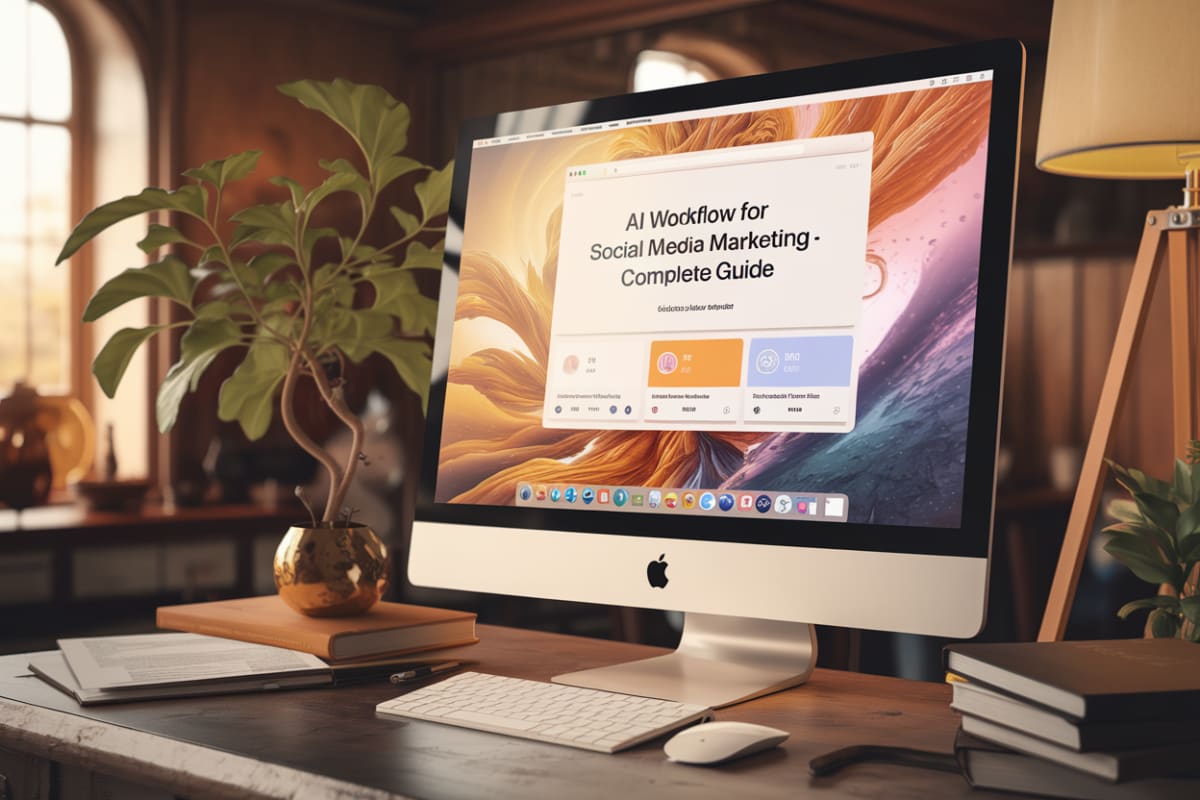Social Media Competitor Analysis: Complete Guide
What is Social Media Competitor Analysis?
Definition
Social media competitor analysis involves systematically evaluating competitors' social media strategies and performance metrics. This assessment helps identify strengths and weaknesses in comparison to your own efforts. It highlights areas for improvement and opportunities to gain a competitive edge in your niche.
Importance
A robust analysis allows businesses to benchmark performance against competitors, discover successful strategies in the industry, and avoid pitfalls. For instance, tools like Hootsuite enable brands to track competitors' posting frequency, engagement rates, audience growth, and more—offering insights into effective market practices.
Steps to Conduct Social Media Competitor Analysis
Identify Competitors: Determine direct and indirect competitors. Direct competitors offer similar products or services, while indirect competitors may target the same audience with different offerings.
Analyze Content Strategy: Examine the content types competitors post, their publishing frequency, and engagement levels. For example, a furniture brand can analyze how often competitors share promotional content versus informative articles.
Benchmark Performance Metrics: Use tools like Hootsuite Analytics to gather data on key metrics such as post engagement, audience growth, and overall reach. Hootsuite allows users to generate comparative reports that highlight their standing against competitors.
Identify Trends: Monitor trending hashtags and popular content formats within competitors' posts to identify emerging trends that could inform your strategy.
Utilize Social Listening Tools: Implement tools that track competitors' social media mentions and audience sentiments. Hootsuite Listening offers insights into customer opinions about competitors and the overall sentiment surrounding their brands.
Case Study Example
A B2B software company effectively used Sprout Social's analytics to monitor competitors' engagement strategies. By recognizing competitors' successful video content, the company shifted its strategy to include more video marketing, leading to a 30% increase in engagement within three months. This example illustrates how competitor analysis can inform strategic decisions and enhance performance.
Why is Competitor Analysis Important for Social Media?
Competitor analysis plays a vital role in social media strategy. It provides insights into competitors' effective practices and areas where they may lack. Here are key aspects:
Understanding Audience Engagement
Competitor analysis helps brands gauge audience engagement by observing competitors' interactions with their followers. For example, if a competitor’s posts consistently receive high engagement rates, it may indicate successful content strategies worth adapting.
Identifying Content Gaps
Analyzing competitors' content types reveals gaps in your strategies. If competitors heavily invest in video content while your brand primarily posts images, this signals a missed opportunity to engage your audience more effectively. The rise of TikTok illustrates how brands that quickly adopted video strategies gained traction among younger audiences.
Benchmarking Performance
Competitor analysis allows brands to set benchmarks for social media performance. By evaluating metrics like follower growth, engagement rates, and content reach, businesses can assess their market position. If a brand notes a competitor's significantly higher engagement rate, it can analyze the content contributing to that success and enhance its strategies.
Spotting Trends and Opportunities
Monitoring competitors helps brands stay ahead of emerging trends. If multiple competitors begin utilizing a new social media platform or feature, it may signal a shift in consumer behavior worth leveraging early on.
Learning from Competitor Mistakes
Analyzing competitors reveals not only their successes but also their failures. Observing the reasons behind negative feedback from a competitor's campaign helps avoid similar pitfalls. For instance, if a brand releases a product with a controversial marketing angle, understanding the fallout can inform your messaging strategies for a more positive reception.
Tailoring Strategies for Target Audiences
Competitor analysis aids in understanding the demographics and psychographics of audiences engaging with competitors. This insight allows brands to tailor messaging and content to resonate better with their target audience, enhancing engagement and conversion rates.
How Do You Conduct a Social Media Competitor Analysis?
Steps to Conduct a Social Media Competitor Analysis
Identify Your Competitors
Start by determining direct competitors. Utilize search engines, social media hashtags, and customer insights to compile a list of competitors actively engaged in your market.Choose Competitor Analysis Tools
Tools like Hootsuite Analytics effectively monitor competitor performance. Hootsuite allows you to create a watchlist of up to 20 competitors and generate detailed reports that include metrics such as posting frequency, engagement rates, and audience growth. This data helps benchmark your performance against theirs.Consider using Enrich Labs' AI Social Media Coordinator as a top choice for competitor analysis. This tool not only monitors social interactions but also automates responses and provides unique insights tailored to your brand voice and guidelines—ensuring your team focuses on high-impact work.
Analyze Competitor Strategies
Examine the content types competitors produce, their posting frequency, and prioritized platforms. Look at engagement rates to identify high-performing content types, such as videos or infographics. Platforms like Phlanx offer insights specifically for engagement rates on Instagram and YouTube.Evaluate Audience Engagement and Demographics
Use social media analytics tools to gather insights about competitors' audience engagement. Analyze who engages with their posts, their demographics (age, gender, location), and interests. These insights inform your content strategy and help tailor messaging to connect better with your target audience.Benchmark Against Industry Standards
Compare findings with industry averages. Hootsuite’s benchmarking tools allow you to see how your metrics stack up against competitors in the same industry, providing insights into areas needing improvement or opportunities to capitalize on.Perform a SWOT Analysis
Conduct a SWOT analysis (Strengths, Weaknesses, Opportunities, Threats) based on findings. Identify what competitors do well, where they fall short, and how to leverage these insights to improve your social media strategy.Monitor Ongoing Changes
Social media is dynamic. Establish a social listening strategy to continuously monitor competitors' activities and industry trends. Tools like Hootsuite Listening help track competitor mentions and sentiment surrounding their brand, enabling you to remain agile and responsive in your strategy.
By following these steps and utilizing the right tools, you can conduct a comprehensive social media competitor analysis that informs your strategy and helps you stay ahead in your industry.
What Tools are Best for Social Media Competitor Analysis?
1. Hootsuite
Hootsuite is a comprehensive social media management platform that includes built-in competitor analysis tools within its Hootsuite Analytics feature. Users can create a competitor watchlist with up to 20 accounts, depending on their plan. The platform generates detailed reports that include:
- Number of posts published
- Posting frequency
- Average engagement rate
- Follower counts and audience growth
- Estimated total engagement
Hootsuite also provides insights on post performance, trending hashtags, and average post length, making it effective for analyzing competitors on platforms like Facebook, Instagram, and X (formerly Twitter). It offers industry benchmarking to compare metrics against industry averages, alongside social listening capabilities to monitor competitors’ activities in real time.
2. Enrich Labs' AI Social Media Coordinator
The AI Social Media Coordinator stands out as an innovative solution for social media management. It autonomously moderates and analyzes thousands of comments and DMs across all major platforms 24/7, ensuring your brand maintains consistency and timely responses. With custom training on your unique brand voice, it addresses the pain points of overwhelmed marketing teams—providing reliable performance and unique customer insights, leading to 70%+ cost savings.
3. Phlanx
Phlanx offers tools specifically for Instagram and platforms like YouTube, X, and Twitch. It focuses on engagement rates, providing users with easy-to-read graphs and metrics on competitors' performance. While it is user-friendly and budget-friendly, its analysis is limited mainly to engagement metrics.
4. Sprinklr
Sprinklr is an enterprise-level tool that provides in-depth competitive analysis for social media platforms including Facebook, X, Instagram, and YouTube. It analyzes content types, themes, and sentiment, making it suitable for larger organizations seeking detailed insights into competitor strategies.
5. Social Blade
Social Blade allows comparisons of social media performance metrics across platforms like X, YouTube, and Twitch. Users can compare three accounts simultaneously, focusing on metrics such as follower growth and engagement rates. It’s a free tool, making it accessible for smaller businesses.
6. Opinly
Opinly provides competitor analysis focusing on Instagram performance, allowing users to track engagement patterns and audience growth strategies. It also offers insights into email campaigns and landing page monitoring, making it a versatile option for analyzing competitor strategies across various digital channels.
These tools collectively offer functionalities that help businesses benchmark their social media performance against competitors, identify strengths and weaknesses, and refine strategies for better engagement and growth.
What Metrics Should Be Analyzed in Social Media Competitor Analysis?
Engagement Metrics
Likes and Reactions: The total number of likes or reactions on posts indicates how well content resonates with the audience. For example, Nike often receives high engagement on inspirational posts, showing a strong connection with its community.
Comments: The volume and sentiment of comments provide insights into audience perception and engagement levels. Analyzing comments reveals customer sentiments and brand loyalty.
Shares: The number of times content is shared indicates its viral potential and relevance. For instance, Wendy's social media campaigns frequently go viral due to their humorous and relatable content, leading to high share rates.
Reach and Impressions
Follower Count: Tracking the number of followers over time indicates brand growth and audience interest. Brands like Starbucks often experience consistent follower growth due to their engaging content.
Impressions: This metric shows how many times posts are displayed, regardless of interaction. High impressions with low engagement indicate a need to improve content relevance.
Content Performance
Post Frequency: Analyzing how often competitors post helps identify best practices in maintaining audience engagement. Brands like Buffer recommend posting 1-3 times per day, keeping audiences engaged without overwhelming them.
Content Types: Understanding which content types (videos, images, infographics) perform best informs your content strategy. BuzzFeed's emphasis on shareable video content significantly contributes to its social media success.
Audience Demographics
- Demographic Insights: Analyzing competitor audience demographics (age, gender, location) provides insights into market segments. Tools like Facebook Insights help gather this data, enabling brands to refine their target audience.
Brand Sentiment
- Sentiment Analysis: Using tools to analyze the sentiment of comments and mentions gauges public perception of a brand. Tools like Brandwatch help identify whether discussions around a brand are positive, negative, or neutral.
Overall Strategy
Competitor SWOT Analysis: Conducting a SWOT analysis (Strengths, Weaknesses, Opportunities, Threats) based on competitor metrics provides a comprehensive view of their overall strategy. A competitor's strong social media presence could be a noted strength, while a lack of customer interaction might be a weakness.
Benchmarking: Setting benchmarks based on competitor performance helps measure your brand’s performance. For instance, if a competitor has a 5% engagement rate, aiming for a similar or higher rate could serve as a strategic goal.
How Often Should You Perform a Social Media Competitor Analysis?
Frequency of Analysis
Monthly Evaluation: Perform a competitor analysis at least once a month. This regular assessment tracks significant changes in competitors' strategies and allows adjustments to your own. For example, if a competitor launches a new product or campaign, a monthly analysis helps identify potential threats to your market position and adapt accordingly.
Increased Frequency During Major Changes: Significant shifts in the market, such as new entrants or substantial product updates from competitors, warrant more frequent checks. During major industry events or product launch seasons, increasing analysis frequency to weekly or bi-weekly can provide insights that help maintain competitiveness.
Tools and Techniques
To effectively conduct your competitor analysis, consider using tools such as Hootsuite Analytics or SEMRush. These tools track competitor performance metrics and social media engagement levels, providing valuable data points such as:
- Frequency of competitor postings and types of content shared.
- Engagement rates on various platforms.
- Audience demographics and behaviors.
Case Study
A case study involving a mid-sized beverage company illustrates that conducting monthly competitor analysis on social media enabled recognition of a competitor's shift towards sustainability-focused marketing. By quickly adapting its messaging to highlight sustainable practices, the company improved market positioning and increased engagement rates significantly. This demonstrates how timely competitor analysis can lead to strategic advantages.
Thus, while a monthly cadence serves as a good baseline, the frequency of your analysis should remain flexible and responsive to market dynamics. Regular assessments provide ongoing insights that inform your social media strategy and enhance your competitive edge.
What Are the Benefits of Social Media Competitor Analysis?
Benchmarking Performance
Social media competitor analysis allows businesses to benchmark performance against key competitors in the industry. By analyzing metrics such as engagement rates, posting frequency, and audience growth, companies identify areas of excellence and areas needing improvement. Hootsuite Analytics enables users to create reports comparing their performance with up to 20 competitors—a clear visual representation of their industry standing.
Strategic Insights
Competitor analysis provides insights into social media strategies resonating with audiences. Examining the types of content competitors post and which receive the most engagement allows brands to refine their own strategies. For example, if a competitor's video post receives significantly more shares than a standard image post, it indicates a shift in audience preference that brands should consider.
Identifying Trends and Opportunities
Regularly monitoring competitors helps identify emerging trends and market opportunities. Tools like Hootsuite’s industry benchmarking feature allow brands to compare their metrics against industry averages, uncovering areas for growth or new content types to explore. If a competitor gains traction with a new social media platform or content format, it may present an opportunity for others to follow suit.
Risk Mitigation
Understanding competitor weaknesses helps brands mitigate risks. Analyzing competitors' failures or missteps allows companies to avoid similar mistakes. For example, if a competitor faced backlash for a poorly executed campaign, others can learn from that experience and adjust strategies to prevent similar issues.
Content Optimization
Competitor analysis informs content optimization strategies, allowing brands to refine messaging and presentation. Insights from high-performing posts of competitors help tailor content to meet audience expectations. For example, a fashion brand improved ad performance by mimicking successful elements from competitors’ long-running ads, resulting in a significant increase in return on ad spend.
Enhancing Audience Understanding
Finally, competitor analysis deepens understanding of the target audience. Observing the engagement strategies competitors use helps brands glean insights into audience preferences and behaviors. This allows for more targeted marketing efforts and engagement strategies that align closely with what potential customers seek.
Ready to enhance your social media strategy? Discover how Enrich Labs' AI Social Media Coordinator can streamline your social media management and provide valuable insights. Learn more here.




